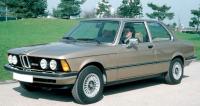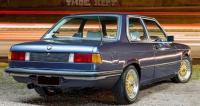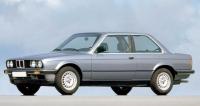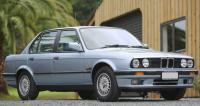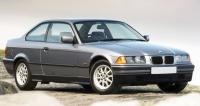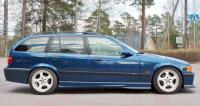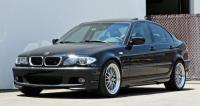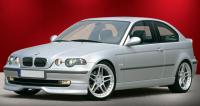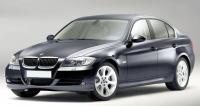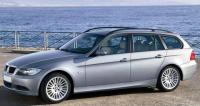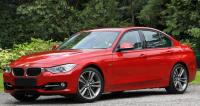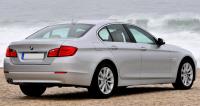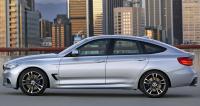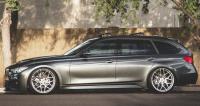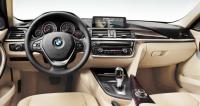First generation (E21; 1975–1983)
The first generation with the E21 body was presented to the public in July 1975 at the Olympic Stadium in Munich. At first, a body was available in the form of a two-door sedan, and in 1978 a two-door convertible appeared. The size of the sedan was 4355 mm long, 1610 mm wide and 1380 mm high. Model names consist of three digits, for example «320», the first of which means the 3rd series, the rest are the engine volume in liters, if you put a decimal point between them. In the example, the engine has a volume of 2.0 liters. If there is a letter at the end «i», means the engine is injection.
Rack and pinion steering, MacPherson type front suspension and transverse wishbone rear suspension. Power brakes on the front wheels were disc while the rear wheels were drum brakes. The motor is located in front with rear wheel drive. Initially there was only a Getrag four-speed manual transmission, in 1980 a five-speed transmission could be chosen, as well as a ZF 3 HP-22 automatic three-speed transmission.
There were three four-cylinder engines with a volume of 1.6, 1.8 and 2.0 liters with a capacity of 74 to 123 hp, two six-cylinder engines with a volume of 2.0 and 2.3 liters with a capacity of 121 and 141 hp. All engines are petrol, diesel options were not.
Second generation (E30; 1982–1994)
The second generation design was conceived in 1978 by NSU Ro 80 designer Klaus Luthe and mass production began in 1982. In total, about 2.3 million cars were produced during the period. Externally, the car is similar to the previous version with two headlights. Initially, two bodies were available - a 4-door and a 2-door sedan, and later a convertible and a 5-door station wagon appeared.
The range of engines has expanded greatly. 1.6, 1.8 and 2.0 liter four-cylinder petrol engines from 90 to 192 hp, 2.0, 2.3, 2.5 and 3.3 liter six-cylinder engines from 123 to 197 hp.With. For the first time, diesel six-cylinder engines with a volume of 2.4 liters with a capacity of 84 (atmospheric) and 114 (turbocharged) hp
A total of eight transmissions were available for various models - five manual and three automatic. Mechanical transmissions 4 and 5 speed firms Getrag. Automatic boxes 3 and 4 speed firms ZF.
Third generation (E36; 1990–2000)
In Europe, the third generation was introduced in 1990. The car has become longer, taller and wider than the previous generation, and also lengthened the wheelbase by 130 mm. The location of the motor in front with a drive to the rear axle. For the entire period, about 2.3 million cars were produced. For the first time, the body was available in hatchback form. There were five body types in total: 2-door coupe, 2-door convertible, 3-door hatchback, 4-door sedan and 5-door station wagon.
The range of engines has also expanded and completely switched to injection models. Four-cylinder engines: two with a volume of 1.6 liters with a capacity of 98 and 101 hp. and six with a volume of 1.8 liters with a capacity of 111 to 138 hp. Six six-cylinder engines with a volume of 2.0 to 2.8 liters with a capacity of 150 to 190 hp. There are five diesel engines with a volume of 1.8 and 2.5 hp. from 89 to 141 hp, all turbocharged. There are four transmission options to choose from - 5 and 6-speed manual or 4 and 5-speed automatic.
Fourth generation (E46; 1998–2006)
In May 1995, the exterior design of the E46 was approved. Four-door sedan appeared in 1998, coupe and station wagon appeared in 1999, convertible in 2000 and hatchback (compact) in 2001. The body of the E46 was claimed to be 70% more rigid than the E36 predecessor. Front engine layout with rear-wheel drive, as well as an all-wheel drive option. The electronics have become more integrated, including the use of a CAN bus system.
The range of 4- and 6-cylinder petrol engines includes 13 modifications with volumes from 1.6 to 3.0 liters and power from 103 to 235 hp, all with direct injection. Diesel engines are five options with a volume of 1.8, 2.0 and 3.0 liters with a capacity of 114 to 201 hp, all turbocharged. Manual transmissions - 5-speed ZF S5-39 and Getrag S5D, 6-speed ZF S6-37. Automatic transmissions - 4-speed GM 4L30-E, 5-speed GM 5L40-E and ZF 5HP19 and 6-speed SMG-II.
Fifth generation (E90, E91, E92, E93; 2004–2013)
The design for the fifth generation of the 3 Series was put on hold in mid-2002 and series production began in December 2004. Front engine layout with rear-wheel drive or all-wheel drive. Body types were as follows - 4-door sedan (E90), 5-door station wagon (E91), 2 door coupe (E92) and 2 door convertible (E93). The sedan has become slightly longer and wider than the previous generation. The front uses MacPherson aluminum struts and the rear is a steel 5- link multi-link suspension.
The range of petrol engines includes 19 models of 4 and 6-cylinders from 1.6 to 3.5 liters with a capacity of 114 to 322 hp. Diesel engines 12 modifications of 4 and 6 cylinders with a volume of 1.6 to 3.5 liters and power from 114 to 282 hp, all turbocharged. Transmission to choose from automatic or manual. In total, about 3 million cars were produced for the entire period.
Sixth generation (F30, F31, F34, F35; 2011–present time)
At the end of 2011, the sixth generation of the BMW 3 series was released. Here, for the first time, turbocharged gasoline engines and electric power steering were used (instead of hydraulic booster). Body types were 4-door sedan (F30), 5-door station wagon (F31), 5 door hatchback (F34, Gran Turismo) and 4-door sedan with extended wheelbase (F35). For models with coupe and convertible bodies, a new series name was allocated - BMW 4 Series.
There are nine modifications of gasoline engines with a volume from 1.6 to 4.0 liters with a capacity from 130 to 320 hp, as well as one gasoline engine in tandem with an electric motor (hybrid) 340 hp Diesel engines of 13 modifications with a volume of 1.6 to 3.5 liters with a capacity of 114 to 310 hp. Transmission automatic (8-speed ZF 8HP45 or ZF 8HP50) or mechanical (6 speed Getrag GS6-17BG or Getrag GS6-45BZ).
In 2015, the generation underwent a cosmetic facelift in appearance, as well as numerous internal changes.
Safety testing of some vehicles
 |  | 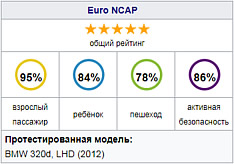 |

